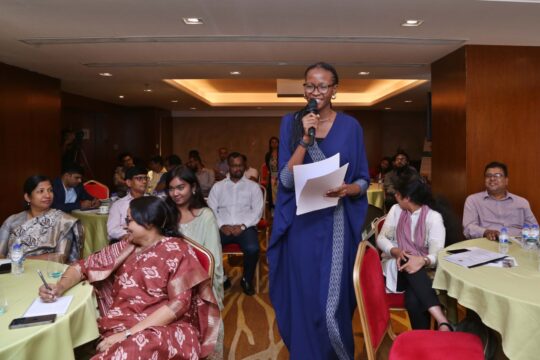PEER enhances national and regional disaster risk reduction and management (DRRM) capacities through disaster preparedness training. The program’s integration at the country level is evident across national institutions that have adopted critical components of PEER in response training. The previous four stages of PEER have expanded the approach to directly address and support institutionalization with each of its progressive stages.
The program’s close-out phase uses previous successes to motivate countries to take ownership of the program by improving engagement with institutions through efforts to scale out and adapt PEER. Over the last four years, since the launch of PEER Phase 5, the countries involved in the program have shown consistent progress in their priority initiatives, even in the face of difficulties presented by the COVID-19 pandemic.
Institutionalization of PEER
Institutionalization of PEER can take many forms. Some partners have started to incorporate PEER into their regular work, while some have mobilized resources outside PEER specifically in agencies that have direct mandates for emergency response operations such as fire services, civil defense, and emergency medical services including red cross/red crescent national societies.
Country-wise progress
Bangladesh
Since 2003, PEER has been supporting Bangladesh in enhancing the response capacity of frontline responders by organizing a number of response training. In these two decades, trained responders have been equipped with the necessary skills to handle emergencies, and the latest search and rescue (SAR) and first aid equipment to reduce disaster risks. The effectiveness of PEER’s curricula and methodology has been demonstrated in the national disaster landscape, leading to increased demand for further training, capacity development among community volunteers, and engagement by various implementing partners in Bangladesh.
Regular preparedness training has been conducted in Bangladesh, resulting in the development of safer health facilities, and the installation of emergency response plans in hospitals. Additionally, a group of trained community volunteers has been developed to act as an auxiliary force to the response services in the country.
India
India is one of the founding members of PEER and has been associated with PEER since 1998. Over the past 25 years, PEER has observed remarkable advancements in disaster risk reduction (DRR) at both the national and local levels in India. Through its training program, PEER has contributed to the development of trained personnel in the National Disaster Response Force (NDRF), which now uses PEER curricula and methodology to provide advanced and basic courses to all its personnel.
To achieve better synergy in disaster risk management (DRM), the PEER methodology and curricula have been implemented at both the state and district levels in India. In addition to training its personnel, NDRF also organizes various community capacity-building programs, such as community awareness initiatives, school safety programs, and mock exercises, to involve the community in reducing disaster risks.
Pakistan
After the 2005 earthquake, Pakistan introduced PEER as a regional program to enhance response capacity, and it soon proved to be a crucial tool in building national-level DRM capacity. The Punjab Emergency Services Department (PESD) Rescue 1122 was one of the first organizations in Pakistan to actively adopt PEER curricula to improve its training mechanism which helped them become the first in South Asia to achieve INSARAG certification. The national response force has also accredited and adopted PEER to enhance the capacity of their personnel, leading to a reduction in response time to just seven minutes.
PEER has also supported other implementing partners in Pakistan, including the National Health Emergency Preparedness and Response Network (NHEPRN), in reviewing and adopting emergency response curricula into their existing training framework. Partners also conduct regular instructor refresher courses to ensure trainers are up-to-date on any changes made to the curriculum and the use of the latest equipment.
Nepal
PEER has been working alongside Nepal to build the emergency response capacity of front liners, for over two decades now. In an effort to institutionalize PEER, National Strategic Plans such as the National DRM Policy and Nepal Red Cross Society (NRCS) Strategy have recognized PEER training and prioritized it as a key aspect of DRR in Nepal.
Moreover, implementing partners across the country have adopted PEER training standards and curricula as a major capacity-building tool in their existing training programs.
Sri Lanka
Sri Lanka has recently added itself to the PEER portfolio. The nation commenced its preparedness program in 2020, and within just three years of implementation, has made significant strides in building disaster risk management capacity in the country. The components of PEER have been incorporated into the National Disaster Management Plan and Strategic Framework for Health Sector Emergency Response, while the Tertiary and Vocational Education Commission (TVEC) has recognized PEER courses for enhancing the capacity of emergency responders.
To further integrate PEER into the country, Sri Lanka plans to utilize its initial investments in DRR to acquire search and rescue tools and establish a national standard equipment list.
Developing a robust disaster response mechanism requires disaster preparedness to be intrinsic to each country’s existing systems and priorities. An integrated approach as a standard for DRM needs to be adopted at the national and local levels. PEER has leveraged this momentum to establish standard training systems and training emergency responders to integrate its approach, goals, and capacity-building activities as an integral part of policies, strategies, budgets, and programs of national institutions and non-government agencies and aim to support in developing safe and resilient nations.


